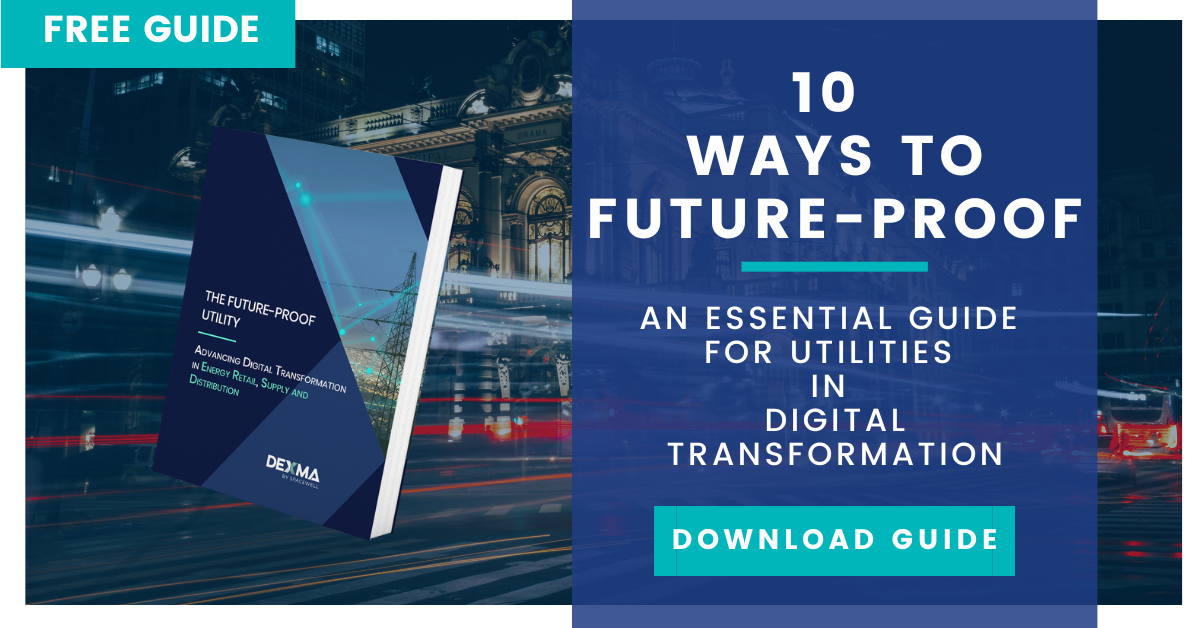Utilities in deregulated markets are under more pressure than ever to attract and retain customers and are therefore more motivated to consider new technologies to extend their energy services offering.
In our previous articles regarding the Future-Proof Utility, we discussed digitalisation and client loyalty as a push for innovation, and the importance of a customer-centric approach. While both of these concepts are of crucial strategic importance, technology is the vehicle that will ultimately bring the future-proof utility into being.
In this article, we will discuss 5 technologies utilities are exploring and investing in, and what kind of capabilities are needed to meaningfully expand their energy services.
Technology that helps increase the utility services offering from selling pure kWh to providing digital energy services is essential in meeting the demands of today’s highly sophisticated, digital-first customer.
An increasing number of utility customers ask for products that can give them more visibility, flexibility and control over their energy consumption. They want to know how and when energy is used, which requires the implementation of smart technology. In addition, a survey conducted by the UK Department for Business Energy & Industrial Strategy (BEIS) found that utilities are trusted by 55% of UK respondents, which represents an amazing opportunity for utilities to create extra value based on insight, data and services.
Unavoidably, utilities that will not adapt to this paradigm shift will find themselves far behind the competition. Indeed, even the world’s biggest companies such as Sasol, Engie and Sinopec have committed to emission reduction targets and are willing to adapt themselves to new requirements and expectations.
Yet, a significant demand gap exists between what utility customers want and what their energy providers are able to offer them from a technological point of view. Here are 5 technologies, from well-established to newly emerging, that will be best placed to fill that gap:
5 Technologies for Data-Driven Utilities
Real-Time Energy Analytics
Utility business customers are increasingly determined to manage their energy consumption patterns in real time.
That is the reason why commercial building owners and facility managers install energy monitors. Indeed, they can close their building energy performance gap by detecting peaks in consumption or forecasting future fuel requirements.
Industrial facilities and manufacturers are especially keen to use predictive analytics to monitor heat and cooling equipment performance: they can automatically alert malfunctions, prevent errors or notify when it is time for maintenance. Even residential customers want on-demand, real-time access to manage and control their personal energy consumption. Utilities are therefore well placed to provide mobile applications and real-time solutions.
Data centres are taking crucial measures to reduce their environmental impact and therefore have excellent Power Usage Effectiveness (PUE) metrics. For instance, Google AI company DeepMind has already achieved a savings rate of 40% on power consumed for cooling purposes alone by using artificial intelligence to optimise energy efficiency.
Similar Big Data and machine learning methods could be applied to utility buildings, evaluate new plant configurations, assess energy efficiency performance, and identify optimisation opportunities. Energy analytics can also help utilities improve grid management by enabling network balancing with production and consumption forecasting, predictive maintenance of grid infrastructure, and the creation and management of demand response programs.
Virtual Audits
Utilities continue to explore innovations based on load disaggregation and behavioural change programmes that use gamification techniques.
Virtual audits are a good example: they use Big Data algorithms to disaggregate utility usage into end uses, such as lighting, pumping, and HVAC. Virtual audits can also identify energy-saving measures by detecting wastage points, peak loads and building automation problems.
Virtual audits can help boost engagement by helping utility customers clearly visualise two important cost-reduction factors: energy use patterns and behaviour, and energy savings potential from retrofits or upgrades to more energy-efficient equipment. They also do it quickly enough to meet the expectations of today’s digital native, always-connected customer – and at a fraction of the cost.
Utilities are especially well-placed to “nudge” their business customers toward data-driven energy efficiency. Many of these commercial and industrial (C&I) customers are responsible for a large portfolio of buildings, which requires a great deal of time to track and review for energy efficiency projects. When hundreds of virtual audit reports can be combined into a single, powerful interface hosted by the utility, business customers will spend more time engaging with their providers to prioritise sites, track projects and evaluate the results.
Demand-Side Management and Demand Response
Data-driven energy analytics can be applied to demand management to benefit utilities in several use cases, including demand response enablement. Significant advances in smart metering, dynamic market-based prices, time-of-use rates, and energy management systems have the potential to make electricity loads more responsive to economic and operational signals than ever.
What kind of specific capabilities do utilities need to roll out successful demand response programs? On the customer experience side, utilities will need to think about program design and delivery – which customers are more likely to participate? What will be their end-to-end journey, from enrolment to rewards?
Internally, utilities will need to be technically capable of forecasting load drops, grouping the customers into virtual power plants (VPPs) based on their distributed energy resource (DER) generating capabilities (think electric vehicles, rooftop solar, smart metres, and self-contained microgrids). Then the utility will need to coordinate dispatch events, bill and settle events, offer rewards for changed customer behaviour and have those changes clearly reflected on each bill.
Similar to virtual audits, demand response programs are complex and require inputs from many different data sources. Managing them through a cloud-based “mission control” dashboard would facilitate interfacing with billions of interconnected device loads connected through the energy Internet of Things. As we mentioned in this article, new data management and control system partnerships with new market actors will be essential in coordinating DERs and their associated energy services, including demand response.
Blockchain
Blockchain acts as the backbone of the decentralised energy system, facilitating energy transition, in which both utilities and consumers produce and sell electricity. Utilities, therefore, need to be ready for a blockchain-enabled near future where peer-to-peer (P2P) wholesale trading, flexibility trading on regional grids and synchronised grid management processes between TSOs, DSOs and end users are the norm. A decentralised market can also shore up revenue for European utilities through efficiency gains, while making pricing data available for anyone to see, thereby opening the market to smaller players.
Lately, in Europe, several utilities have already shifted towards this efficient and cost-effective technology. Some trading firms converged to conduct P2P trading in the wholesale energy market using the Enerchain framework – an application that was used to execute the first European energy trade over the blockchain last year. The goal of Enerchain is to create a blockchain-driven exchange that provides energy wholesalers with a way to list and sell expected future energy generation.
In the UK, the company Electron has developed a blockchain-based digitally optimised marketplace through its ElectronConnect platform.
Artificial Intelligence
Utility providers have a less than savoury reputation among consumers when it comes to customer experience, as we explain in previous articles. Long hold times, complicated processes, and a lack of empathy in communication are among the problems facing customers when dealing with their energy providers.
Chatbots are one way utilities can offer an always-on connection to their customers, providing peace of mind and eliminating fears of unresponsiveness. With a chatbot, utilities can automate the most repetitive customer service requests and offer the transparent, direct and solution-driven communication that customers have come to expect. Gone are the days of waiting for an email reply! No more listening to that terrible hold music or explaining your issue for the nth time!
Mobile messaging and automated chatbots have additional uses, such as providing customers with relevant and updated information in real time, during emergencies or outages for example. When customers feel connected, safe and informed, the quality of the relationship is elevated – churn is reduced and retention rates start to go up.
Time to hear about some real examples. The British Gas chatbot is in charge of booking smart meters appointments; together with Amazon, EDF launched the Alexa skill, enabling the linking of any Eco to an existing customer account; customers can ask the E.on chatbot for a deferment, guiding them through the process, from start to finish. Formerly, in 2017, E.ON launched Sam, supposedly the energy industry’s first ever virtual assistant specifically designed to offer customers a smarter solution to help them manage their energy accounts when they’re moving home.
By no means an exhaustive list, each of these 5 technologies can be a potential vehicle to deliver the proactive energy management required by the utility of the future. Over time, we can say with confidence that a broad array of new technologies will find their way onto the “retailised” grid as utility offerings. These changes are already happening as OEMs, startups, new entrants and VC funds bring new data-driven technologies to revolutionise the power sector.
It is up to utilities to find ways to incorporate these emerging energy services into their business models and tailor them to each customer segment. Our decade of experience has shown that collaboration and synergy between agile technology experts and incumbents is a winning combination to make this a reality.
Don’t get left behind in the transition to a new era of decentralised power – Get in touch with our experts.





